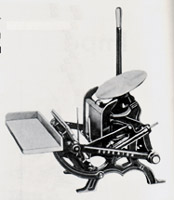|
|||
| INTRODUCTION Craftsmen Machinery Company produced presses very similar to the most popular presses of the small-press era. In fact, they were nearly identical copies. Furthermore, Craftsmen seems to have used the original Sigwalt, Caxton, Golding, Victor and other defunct manufacturer's presses as the casting patterns for the presses shown in this 1955 catalog. A comparison of an original Victor Press Company 4x6 press in our collection with the Craftsmen 4x6 "Victory" press shown below shows a 1% difference in size. 1% is the amount of shrinkage normally associated with cast-iron production. To us, this confirms the theory that Craftsmen presses are direct copies of other popular presses from the turn of the century. This has lead to some confusion over models and model names - as well as the fit of replacement or after-market press parts. The scan below is from the 1955 Craftsmen Catalog. 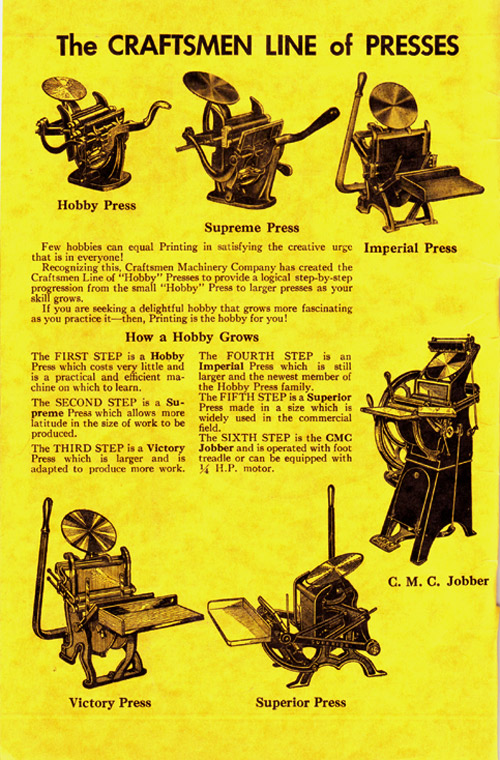
Craftsmen Machinery (U.S.) Catalog from 1955 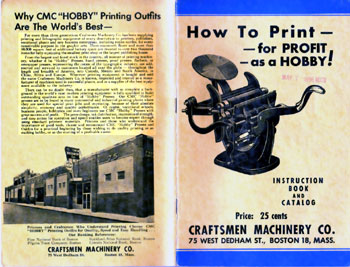  click either image above to see enlarged version 9x12 Craftsment Monarch (not shown in 1955 catalog) 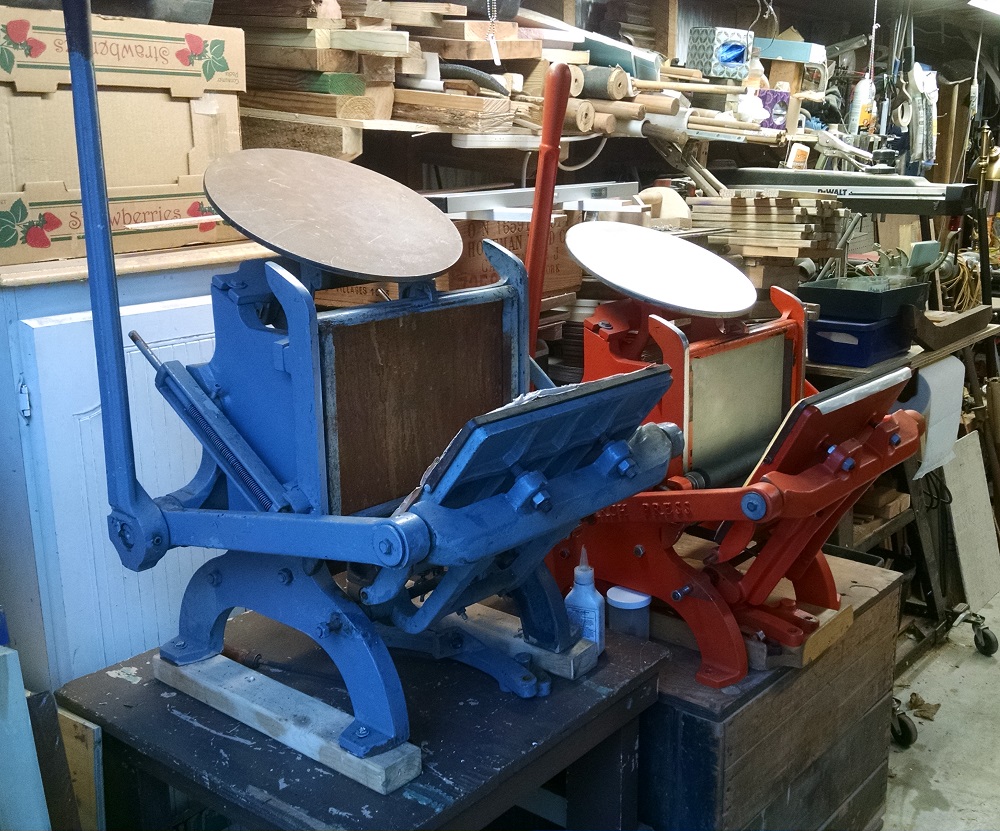 Craftsmen made one of the largest
table top platen presses ever built - the 9x12 Monarch. Craftsmen made one of the largest
table top platen presses ever built - the 9x12 Monarch.These two are here for repair and set up for printing. The gray one in the photo here was cast of iron; the orange one was made in Canada and cast of aluminum. The aluminum disk is cast with additional material in a ring around the teeth. The cast iron disk did not need to be reinforced. 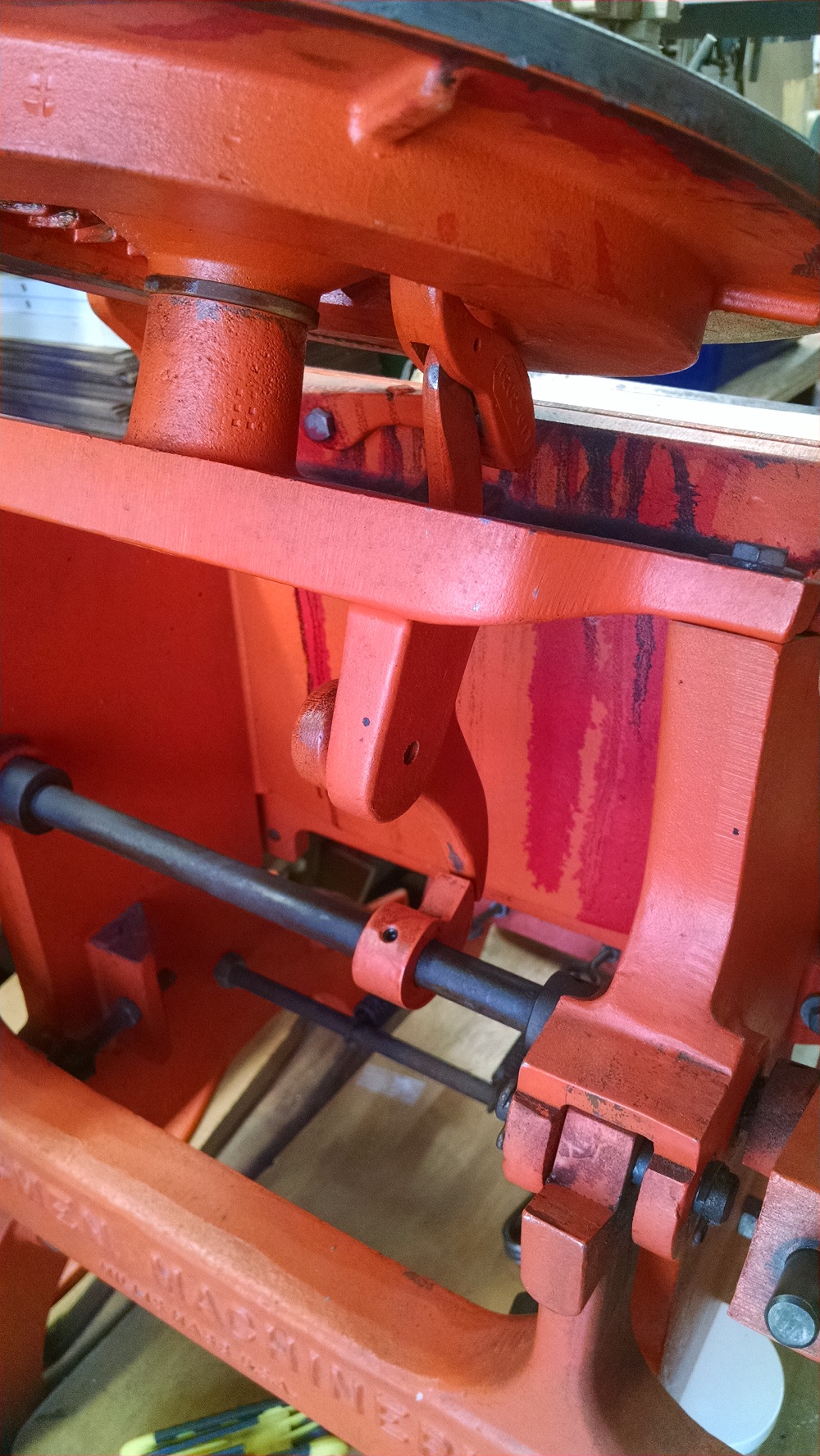 But
both suffer from the same - quite serious problem; the
ink disk does not always advance and when it does move
at all, it's not very much. But
both suffer from the same - quite serious problem; the
ink disk does not always advance and when it does move
at all, it's not very much. The cause of this problem is two part. First of all, the disk must be shimmed to the correct height above the disk holder. These presses rquire different thickness shims. The second part of the problem appears to be the length of the cam leg that forces the striker against the disk teeth. 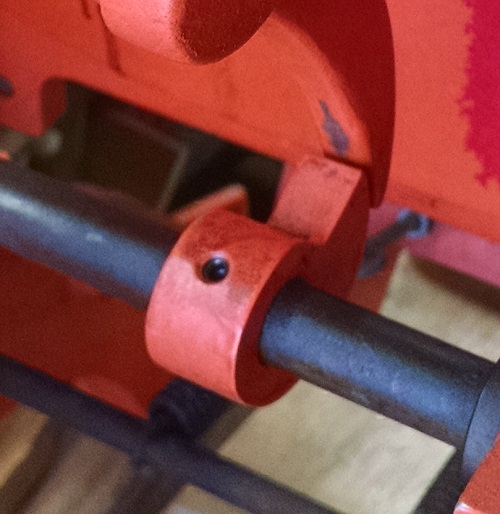 It simply
does not push the striker far enough to rotate the disk
and then return to the correct home position. This
appears to be a design flaw. It simply
does not push the striker far enough to rotate the disk
and then return to the correct home position. This
appears to be a design flaw. Craftsmen was never known for excellent design. In fact, most (if not all) of their presses were copies of other companies' designs and share little design features in common. This press, for example, appears to be an oversized version of the venerable C&P Pilot, initially designed by H.H. Thorpe in 1888 - and not much modified or improved aside from one design change to "New Style" Pilots by Chandler & Price. Craftsmen's "Superior" press was initally a copy of Thorpe's orginal "Old Style" design, and later was a copy of the New Style design made by Chander & Price. We propose to install an extension to this cam, which should increase the stroke length of the striker, thereby not only forcing the rotation to increase, but also to enable the return of the striker to a good position beneath the tooth to drive it further as the press is opened. What's interesting is the Chandler & Price *designed* their striker to wear, and added a replaceable blade to the end of the striker. What I propose will add a replaceable extension to the cam that drives the striker - sufficient distance to leave a tooth in the right position above it when it returns to home position. This way, it will catch the tooth and drive the disk as the press opens. In both cases, this assures continued successful operation, accounting for wear. The Craftsmen do not appear to be wear issues, however. I believe that they were simply poorly designed. The parts needed are there, all right, but they don't work well together. But they will. And, when they do, we will do some printing on these presses and add to this report. Update 4/19: Well, it seems as though I have discovered - and solved (I think) another problem with the manufacture of this 9x12 Monarch. I was concerned because the ink rollers did not go up as far on the ink disk as I thought they should. When I inked the press, no ink was transferred to the center - it was a blank, round spot. This could not be intentional. In addition, the rollers touched the top of the platen - leaving a line of fresh ink on the top edge of the tympan sheet. This is no way to print! This is caused by the side linkage that actuates the roller carriage. It was too short! In fact, when I compared it to the linkage on my 6 1/2 x 10 C&P Pilot, it was the same! How could this be? The 9x12 is much larger than the C&P Pilot. And then, I got to thinking... Craftsmen cloned other manufacturer's presses. They did not design new presses of their own. They copied other presss - and copied others' mistakes. But in this case, I knew that Craftsmen also copied the Thorpe/C&P Pilot. So, I got to thinking... "what if..." and it turns out that the linkage used on these two 9x12 Monarch presses was actually a Pilot link!!! I made a new one - 1/4" longer than the original - with the mounting holes 1/4" further apart. Now the rollers roll as I would expect and the ink disk no longer has a bald spot in the center. I think that what happened was either that the assemblers grabbed the wrong part (there is only 1/4" difference in the placement of the mounting holes) or they ALL used the wrong part... Curious... We'll do some printing on this press tomorrow and add another update with the results.... Chase size and Lever actuated vs Flywheel-driven presses Another point worth making regarding the size of this press' chase:. The chase of the Monarch is almost as large as the 9x13 chase of the Kelsey Excelsior 9x13 and larger than the chase of the popular 8x12 Chandler & Price press. However, the C&P is a flywheel-driven press whereas this one is a lever-operated press. They operate at different speeds and the flywheel of the C&P enables momentum stored in the mass of the flywheel to accomplish a stronger, momentary dwell of the platen (& paper) against the form. To match this amount of pressure, quite a bit of force would have to be applied to the lever of the Monarch. This could stress the castings - either cast iron or aluminum, and cause damage to the press. Historically, a pipe would often be added to the side arm lever of the C&P Pilot press, resulting in many Pilot handles and rocker shafts being broken due to stress. I have repaired Pilot presses damaged in this way. This press carries that same potential - IF the printer tries to apply more pressure - to get more "punch" in the impression... |
|||
|
page last updated
|

